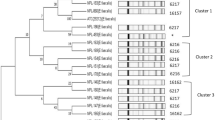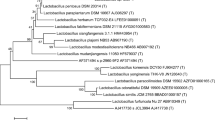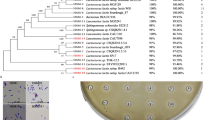Abstract
Human milk is a vital fluid that contains various nutrients and a complex bacterial community, which plays a significant role in shaping infant gut microflora. In the present study, Lactobacillus gasseri strain HN1 was isolated from the human milk of Indian healthy mothers fed on a normal North Indian vegetarian diet during the postpartum period, and its probiotics properties were evaluated. The isolated culture was identified based on its morphological and biochemical characteristics and genetic relatedness was assessed through 16S rRNA gene sequence comparison. Probiotic parameters such as tolerance to low pH, resistance to bile salt concentrations, cell surface hydrophobicity, antibiotic susceptibility, and antimicrobial activity was investigated. The strain exhibited survivability up to 3 h at pH of 2.0 and 3.0, while considerable tolerance (p < 0.05) up to 8 h at 0.5 and 1.0% bile concentration was observed. The culture exhibited substantial resistance against antibiotics such as ciprofloxacin and trimethoprim. The antimicrobial activity against S. epidermidis MTCC 9041 and S. lentus was most pronounced, with an inhibition zone of more than 25 mm. The strain exhibited β-galactosidase activity (0.5 U/mL) and possessed good adhesion potential. The results indicated that L. gasseri HN1 could be a prominent probiotic candidate to be used in the formulation of infant foods, dairy products and industrial applications.





Similar content being viewed by others
REFERENCES
Asan-Ozusaglam, M. and Gunyakti, A., Lactobacillus fermentum strains from human breast milk with probiotic properties and cholesterol-lowering effects, Food Sci. Biotechnol., 2019, vol. 28, no. 2, pp. 501–509.
Ballard, O. and Morrow, A.L., Human milk composition: nutrients and bioactive factors, Pediatr. Clin. North Am., 2013, vol. 60, no. 1, pp. 49–74.
Boix-Amorós, A., Collado, M.C., and Mira, A., Relationship between milk microbiota, bacterial load, macronutrients, and human cells during lactation, Front. Microbiol., 2016, vol. 7, pp. 1–9.
Boix-Amoros, A., Puente-Sánchez, F., Du Toit, E., Linderborg, K.M., Zhang, Y., Yang, B., Salminen, S., Isolauri, E., Tamames, J., Mira, A., and Collado, M.C., Mycobiome profiles in breast milk from healthy women depend on the mode of delivery, geographic location, and interaction with bacteria, Appl. Environ. Microbiol., 2019, vol. 85, no. 9, pp. 2994–18.
Carević, M., Vukašinović-Sekulić, M., Grbavcic, S., Stojanović, M., Mihailović, M., Dimitrijević, A., and Bezbradica, D., Optimization of β-galactosidase production from lactic acid bacteria, Hem. Ind., 2015, vol. 69, no. 3, pp. 305–312.
Castro, W., Navarro, M., and Biot, C., Medicinal potential of ciprofloxacin and its derivatives, Future Med. Chem., 2013, vol. 5, no. 1, pp. 81–96.
CLSI, Performance Standard for Antimicrobial Susceptibility Testing: Twenty—Forth Informational Supplement 34: M100-S124, PA, 2014.
da Cunha, L., Ferreira, C.L.L.F., Durmaz, E., Goh, Y.J., Sanozky-Dawes, R., and Klaenhammer, T., Characterization of Lactobacillus gasseri isolates from a breast-fed infant, Gut Microbes, 2012, vol. 3, no. 1, pp. 15–24.
de Vrese, M., Stegelmann, A., Richter, B., Fenselau, S., Laue, C., and Schrezenmeir, J., Probiotic—compensation for lactase insufficiency, Am. J. Clin. Nutr., 2001, vol. 73, no. 2, pp. 421–429.
Ghanbari, M., Jami, M., Domig, K.J., and Kneifel, W., Seafood biopreservation by lactic acid bacteria—a review, LWT Food Sci. Technol., 2013, vol. 54, no. 2, pp. 315–324.
Gil-Campos, M., López, M.Á., Rodriguez-Benitez, M., Romero, J., Roncero, I., Linares, M., Maldonado, J., López-Huertas, E., Berwind, R., Ritzenthaler, K.L., Navas, V., Sierra, C., Sempere, L., Geerlings, A., Maldonado-Loban, J.A., et al., Lactobacillus fermentum CECT 5716 is safe and well tolerated in infants of 1–6 months of age: a randomized controlled trial, Pharmacol. Res., 2012, vol. 65, no. 2, pp. 231–238.
Gunyakti, A. and Asan-Ozusaglam, M., Investigation of the potential use of Lactobacillus gasseri originated from human breast milk as food additive, LWT Food Sci. Technol., 2018, vol. 93, pp. 613–619.
Gunyakti, A. and Asan-Ozusaglam, M., Lactobacillus gasseri from human milk with probiotic potential and some technological properties, LWT Food Sci. Technol., 2019, vol. 109, pp. 261–269.
Haiden, N. and Ziegler, E.E., Human Milk Banking, Ann. Nutr. Metab.,2016, vol. 69, pp. 8–15.
Hunt, K.M., Foster, J.A., Forney, L.J., Schütte, U.M.E., Beck, D.L., Abdo, Z., Fox, L.K., Williams, J.E., McGuire, M.K., and McGuire, M.A., Characterization of the diversity and temporal stability of bacterial communities in human milk, PLoS One, 2011, vol. 6, no. 6, pp. 1–8.
Iyer, B.K., Singhal, R.S., and Ananthanarayan, L., Characterization and in vitro probiotic evaluation of lactic acid bacteria isolated from idli batter, J. Food Sci. Technol., 2013, vol. 50, no. 6, pp. 1114–1121.
Jacobsen, C.N., Rosenfeldt Nielsen V., and Hayford A.E., Screening of probiotic activities of forty-seven strains of Lactobacillus spp. by in vitro techniques and evaluation of the colonization ability of five selected strains in humans, Appl. Environ. Microbiol., 1999, vol. 65, pp. 4949–4956.
Jamyuang, C., Phoonlapdacha, P., Chongviriyaphan, N., Chanput, W., Nitisinprasert, S., and Nakphaichit, M., Characterization and probiotic properties of Lactobacilli from human breast milk, 3 Biotech., 2019, vol. 9, no. 11, pp. 1–11.
Kara, F., Release and characterization of beta-galactosidase from Lactobacillus plantarum, M. Sci. Thesis, 2004.
Katla, A.-K., Kruse, H., Johnsen, G., and Herikstad, H., Antimicrobial susceptibility of starter culture bacteria used in Norwegian dairy products, Int. J. Food Microbiol., 2001, vol. 67, pp.147–152.
Kozak, K., Charbonneau, D., Sanozky-Dawes, R., and Klaenhammer, T., Characterization of bacterial isolates from the microbiota of mothers’ breast milk and their infants, Gut Microbes, 2015, vol. 6, no. 6, pp. 341–351.
Liu, W., Chen, M., Duo, L., Wang, J., Guo, S., Sun, H., Menghe, B., and Zhang, H., Characterization of potentially probiotic lactic acid bacteria and bifidobacteria isolated from human colostrum, J. Dairy Sci., 2020, vol. 103, no. 5, pp. 4013–4025.
Mainville, I., Arcand, Y., and Farnworth, E.R., A dynamic model that simulates the human upper gastrointestinal tract for the study of probiotics, Int. J. Food Microbiol., 2005, vol. 99, no. 3, pp. 287–296.
Mane, A., Khan, I., and Thakar, M., Characterisation of colonisation properties of vaginal lactobacilli from healthy Indian women: Implications for identification of potential probiotic candidates, Indian J. Microbiol., 2020, vol. 38, nos. 3–4, pp. 440–443.
Martin, R., Langa, S., Reviriego, C., Jiminez, E., Mar-tin, M.L., Xaus, J., Fernández, L., and Rodriguez, J.M., Human milk is a source of lactic acid bacteria for the infant gut, The J. Pediatr., 2003, vol. 143, no. 6, pp. 754–758.
Oh, N.S., Lee, J.Y., Oh, S., Joung, J.Y., Kim, S.G., Shin, Y.K., Lee, K.W., Kim, S.H., and Kim, Y., Improved functionality of fermented milk is mediated by the synbiotic interaction between Cudrania tricuspidata leaf extract and Lactobacillus gasseri strains, Appl. Microbiol. Biotechnol., 2016, vol. 100, no. 13, pp. 5919–5932.
Oleskin A.V. and Shenderov B.A., Microbial Communication and Microbial Host Interactions: Biomedical, Biotechnological, and Biopolitical Implications, Hauppauge NY, USA: Nova Sci., 2020.
Pino, A., Bartolo, E., Caggia, C., Cianci, A., and Randazzo, C.L., Detection of vaginal lactobacilli as probiotic candidates, Sci. Rep., 2019, vol. 9, no. 1, pp. 1–10.
Rastogi S., Mittal V., and Singh A., In vitro assessment of antioxidant and antimicrobial potential of Lactobacillus gasseri strains isolated from human milk and infant faeces, J. Pure Appl. Microbiol., 2020, vol. 14, pp. 1305–1315.
Salamone, M. and Di Nardo, V., Effects of human milk oligosaccharides (HMOs) on gastrointestinal health, Front. Biosci., 2020, vol. 12, pp. 183–198.
Selwal, K.K. and Selwal, M.K., Evaluation of viability and “in vitro” probiotic properties of Lactobacillus acidophilus NCDC 15 cultures before and after freeze drying, Minerva Biotecnol., 2014, vol. 26, no. 3, pp. 137–142.
Serrano-Nino, J.C., Solis-Pacheco, J.R., Gutierrez-Padilla, J.A., Cobian-Garcia, A., Cavazos-Garduno, A., González-Reynoso, O., and Aguilar-Uscanga, B.R., Isolation and identification of lactic acid bacteria from human milk with potential probiotic role, J. Food Nutr. Res., 2016, vol. 4, no. 3, pp. 170–177.
Shin, S.P., Choi, Y.M., Kim, H., Hong, S.P., Park, J.M., Kim, J., Kwon, O., Lee, E.H., and Hahm, K.B., A double blind, placebo-controlled, randomized clinical trial that breast milk derived-Lactobacillus gasseri BNR17 mitigated diarrhea-dominant irritable bowel syndrome, J. Clin. Biochem. Nutr., 2018, vol. 62, no. 2, pp. 179–186.
Siscovick, D.S., Barringer, T.A., Fretts, A.M., Wu, J.H.Y., Lichtenstein, A.H., Costello, R.B., Kris-Etherton, P.M., Jacobson, T.A., Engler, M.B., Alger, H.M., Appel, L.J., and Mozaffarian, D., Omega-3 polyunsaturated fatty acid (fish oil) supplementation and the prevention of clinical cardiovascular disease: a science advisory from the American Heart Association, Circul., 2017, vol. 135, no. 15, pp. 867–884.
Tanaka, H., Doesburg, K., Iwasaki, T., and Mierau, I., Screening of lactic acid bacteria for bile salt hydrolase activity, J. Dairy Sci., 1999, vol. 82, no. 12, pp. 2530–2535.
Tiago, F.C.P., Martins, F.S., and Souza, E.L.S., Adhesion to the yeast cell surface as a mechanism for trapping pathogenic bacteria by Saccharomyces probiotics, J. Med. Microbiol., 2012, vol. 61, pp. 1194–1207.
Turkova K., Rittich B., and Spanova A., Identification and determination of relatedness of lactobacilli using different DNA amplification methods, Chem. Pap., 2012, vol. 66, pp. 842–851.
Wesolowska, A., Sinkiewicz-Darol, E., Barbarska, O., Bernatowicz-Lojko, U., Borszewska-Kornacka, M.K., and van Goudoever, J.B., Innovative techniques of processing human milk to preserve key components, Nutrients, 2019, vol. 11, no. 5, p. 1169.
Witkowska-Zimny, M. and Kaminska-El-Hassan, E., Cells of human breast milk, Cell. Mol. Biol. Lett., 2017, vol. 22, p. 11.
WHO, Evaluation of health and nutritional properties of probiotics in food including powder milk with live lactic acid bacteria. Expert consultation report, Food and Agriculture Organization of the United Nations and World Health Organization, Córdoba, Argentina, October 1–4, 2001).
Zárate, G., Gonzalez, S., Chaia, A.P., and Oliver, G., Effect of bile on the beta-galactosidase activity of dairy propionibacteria, Le Lait., 2000, vol. 80, no. 2, pp. 267–276.
Funding
The first author gratefully acknowledges the financial support provided by the Indian Council of Medical Research, New Delhi, to research under the junior research fellowship (grant no. 3/1/3/JRF-2017/HRD-LS/50430/89).
Author information
Authors and Affiliations
Corresponding author
Ethics declarations
The authors declare that they have no conflicts of interest.
This article does not contain any studies involving animals or human participants performed by any of the authors.
Rights and permissions
About this article
Cite this article
Nirvan, H., Selwal, M.K., Deswal, G. et al. Evaluation of Probiotic Characteristics of Lactobacillus gasseri HN1 Isolated from Breast Milk of Indian Mothers. Microbiology 91, 783–791 (2022). https://doi.org/10.1134/S0026261722100812
Received:
Revised:
Accepted:
Published:
Issue Date:
DOI: https://doi.org/10.1134/S0026261722100812




